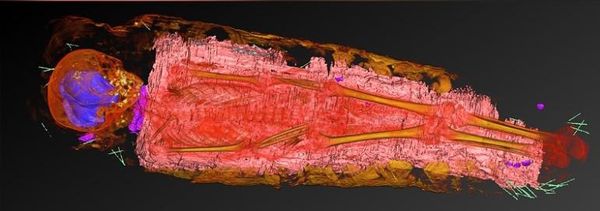
Two decades ago, scientists performed X-ray scans on a child mummy excavated in 1910 at the ancient Egyptian site of Hawara, dating from the time when Egypt was ruled by the Roman Empire. Now, the mummy has been revisited with updated technology. The high-resolution scans revealed some peculiar objects stashed in the mummy’s abdomen that had initially been concealed.
The body of the ancient mummy belonged to a girl child who was only 5 years old when she died. Known as Hawara Portrait Mummy No. 4, the mummy is currently stored in the collection of Northwestern University’s Block Museum of Art.
Like many other mummies from ancient Egypt under Roman rule, the mysterious girl’s mummy had a portrait attached to the front surface. Although the portrait is that of an adult woman, the small mummy is definitely that of a child — so young that none of her permanent teeth had yet emerged.
Using a combination of computed tomography (CT) and X-ray diffraction for the first time, researchers at the Northwestern University’s Feinberg School of Medicine in Chicago created a 3D map of the contents of the mummy.
Dozens of X-ray microbeams smaller than the width of a human hair were shone onto the mummy, which revealed small objects hidden inside the mummy case.

One of the hidden artifacts is a small chunk of calcium carbonate with a high degree of purity. The opaque object is about the shape of a scarab, a symbol of rebirth.
The size and positioning of the scarab suggest it could be an amulet that was placed in the mummy’s wrappings over the abdomen to protect the child in the afterlife. Yet this is still relatively speculative since the CT scan’s resolution wasn’t high enough to make out the nature of the object with a high degree of certainty.
In any event, a pure calcium carbonate scarab wasn’t cheap, hinting about the social status of the mummy. The person was probably from the upper echelons of Egyptian society, perhaps even royalty.

Although the researchers cannot establish the cause of death of the five-year-old girl, the CT scans did not reveal any sign of skeletal trauma, so a violent end can be ruled out.
As often happens with ancient burials, studies like these raise more questions than they answer. But that’s just expected when dealing with any good mystery.
The findings appeared in the Journal of the Royal Society Interface.


